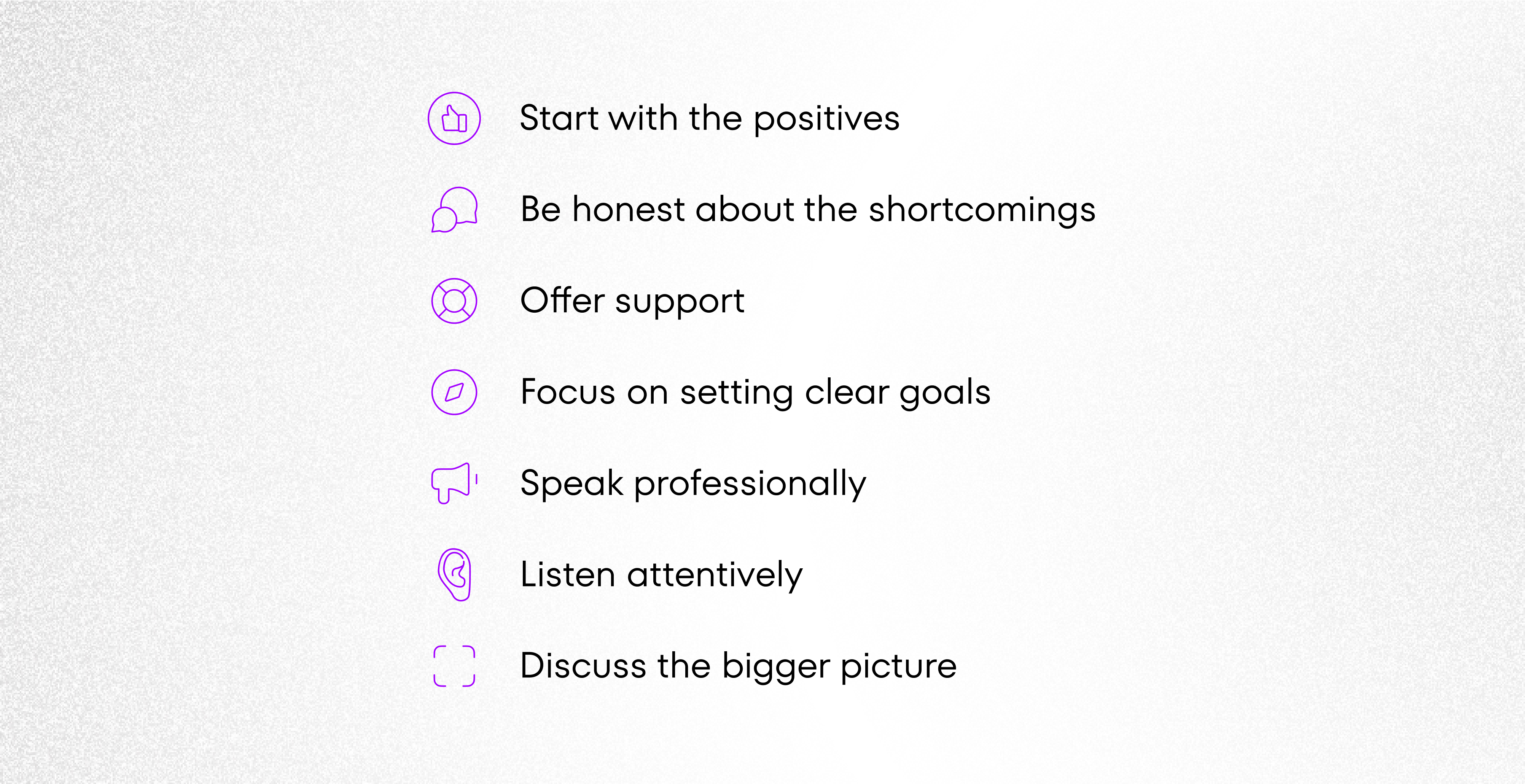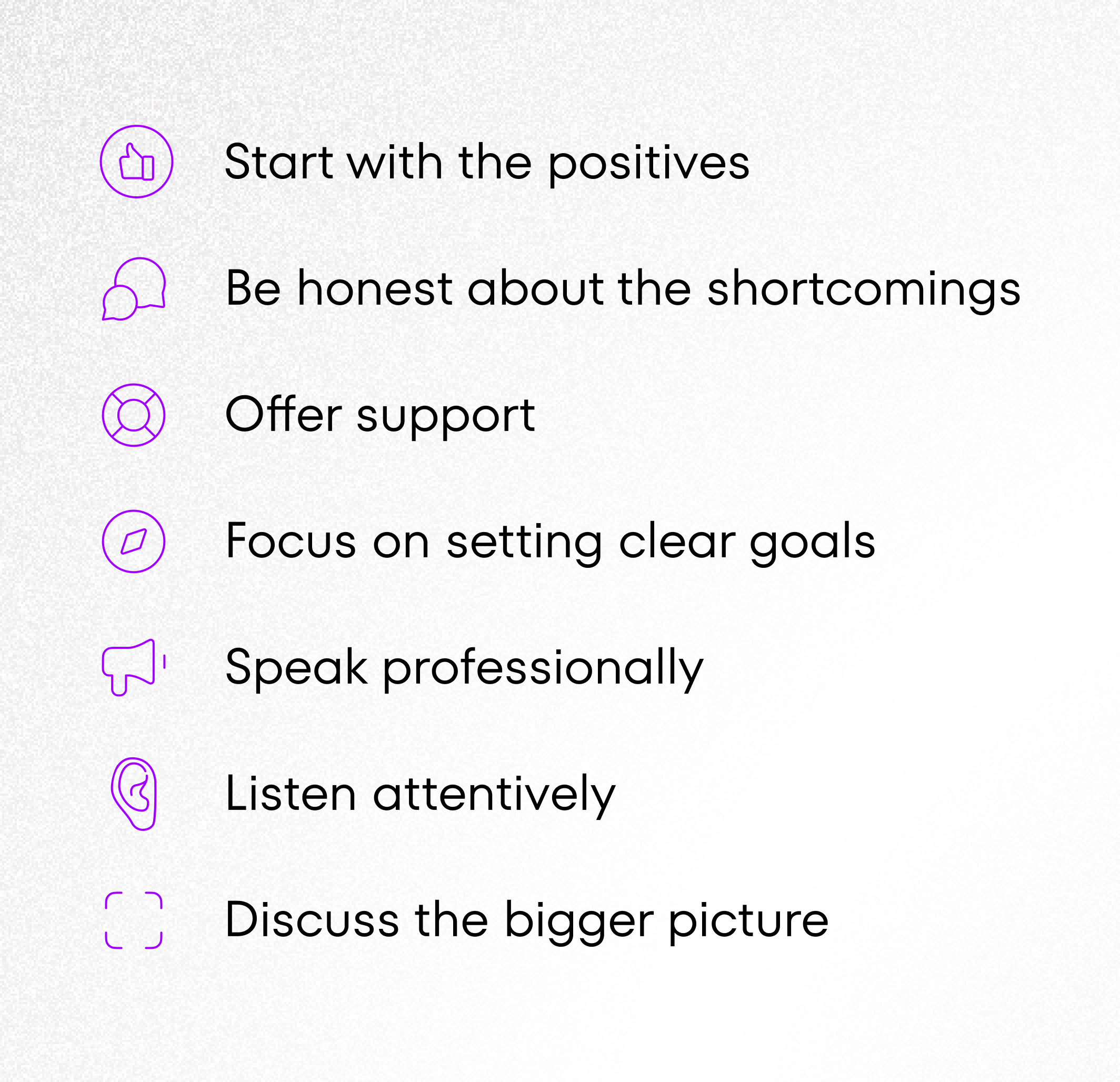March 29th, 2021 | by Jacek Fiałkiewicz
The Art of Conducting Performance Reviews: 7 Tips for an Effective Review Meeting

Table of contents
I’ve recently discussed the importance of conducting performance review meetings and how we approach this complex but vital process in the development of a company and its employees. In the final article in this series, I provide you with several tips that will help you conduct the review meeting in a useful and constructive manner.
The importance of doing it right.
You may think that a performance review meeting is just another one-on-one with your team member, but it’s a lot more than that: it’s a unique opportunity to convey a message that could have a great impact on how the employee approaches their work. It’s an opportunity to reassure them that the organization cares about their career advancement, which is important for most employees.
A review meeting is also a great chance to motivate, clarify expectations and give directions on how the team members could improve their performance. Helping employees improve their performance and decrease staff rotation rates. To achieve these, however, you need to have the right approach and be aware of certain tactics and their consequences. If you don’t follow them, the entire effort can go down the drain. Here’s what you should keep in mind:
-
Start with the positives
The performance review meeting is one of the most important tools to effectively appraise the performance of individual employees. It’s a good strategy to start with the positives because it will help build rapport and trust in the atmosphere of the meeting. According to Maren Hogan in her article on LinkedIn, “5 Employee Feedback Stats That You Need to See”, about 70% of employees state they would be keen to work harder if their efforts were more recognized by management. So, praise anything that is praiseworthy. Such an approach will help you avoid being biased in evaluating your coworker’s performance. Employees usually have questions about their own performance and want to receive feedback that clarifies what they do well – it helps them build confidence in their own actions and quality of work.
About 70% of employees state they would be keen to work harder if their efforts were more recognized by management.
Be honest about the shortcomings
I know this may be the most difficult part of the review meeting, but it is your responsibility as the manager to correct any shortcomings. Say openly what needs to change and/or improve. This is crucial both for the success of the employee and the entire company. It may be tough for the employee to hear it, but you can’t beat about the bush. In the end, you are dealing with a professional who needs to be able to face the consequences of their actions. You must be prepared to face a variety of reactions in response, as some people may take it more emotionally than others. Outline these shortcomings as lessons learned for the future and…
Offer support
Receiving critical comments can be stressful even for the toughest of characters and may leave some of them feeling somewhat paralysed. Assure that you are there to help them in this improvement process, and even the hardest truth will be much easier to digest for them. Explain to the employee that their success and professional growth are important to you and the company, and they will be more willing to cooperate. They need to trust that you are available to help them on this professional development journey, so ask if they need anything in the coming weeks. This can be a good starting point for further planning.
Focus on setting clear goals
One of the purposes of a performance review meeting is to persuade the team members to improve their performance and/or change behavior. For the meeting to be constructive, ensure you set clear goals, which will guide the employees as to how their performance can be improved. The team members must understand exactly what is expected from them and how they will be evaluated against those expectations – otherwise, they will simply feel lost. Explain to them as precisely as possible how they are expected to improve instead of just indicating the areas where they need to improve.
Speak professionally
This is about being specific, objective and understanding that what you choose to not mention is just as important as what gets said out loud. Avoid provocation, sarcasm, personal comments, any kind of ambiguous language or generalizations, which may completely deflate the value of employee’s work as well as their self-confidence. This is a serious meeting that doesn’t allow room for any kind of hidden agenda or hearsay. In this context, which tends to be rather stressful for all participants, jokes may not be accepted as they are intended to be. Be thoughtful, considerate, and mindful of your employee’s emotions.
Listen attentively
The performance review meeting has to be a two-way conversation, so provide space for the employee to ask questions and share their feedback about the workplace, processes, and anything else they deem important. Remember that the performance review meeting is all about the employee, so offer room for explanation or sharing what’s currently going on in their personal lives. They may currently be going through tough events that also impact their performance. Above all, do listen and act upon what you hear – if the employee raises vital concerns or suggestions for improvements, share it with relevant stakeholders. This will help you build trust and strengthen the relationship with your employee.
Discuss the bigger picture
As the meeting ends, it’s good to talk about team goals and organizational priorities in an attempt to align them with the employee’s professional priorities and goals, especially if there were changes in focus or direction. List the skills that the employee should strengthen in order to achieve specific objectives and highlight that his work towards achieving these objectives will have a direct impact on their career progression and negotiating a pay rise. Agree on a timeline for achieving these goals, and when you meet again to review progress – this is particularly important for the employee to know whether they are on the right track and for you to know whether you should provide more assistance.
7 Tips for an effective review meeting


Wrap up
Performance review meetings certainly aren’t easy to lead, but doing it right is critical both for the professional growth of the employees and for business efficiency. It’s an opportunity to constructively indicate what needs to improve and how it should be done – to teach a vital lesson. Successful review meetings will bring positive outcomes, but don’t forget the risks that arise before, during, and after the performance review meeting.
Also, make sure that you have a clear understanding of the goals and objectives of your company before starting the meeting in order to have a basis for evaluating the efficiency of your team members. Once you’re done with this review, you can prepare for the conversation.


